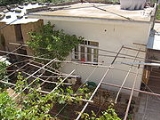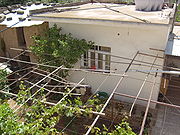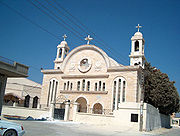
Fairouzeh
Encyclopedia
Fairouzeh is an Assyrian/Syriac village near the city of Homs
, Syria
. It is located 3 miles (5 كم) Southeast of Homs. Due to the huge expansion of buildings around the original village, Fairouzeh similarly to Zaidal is now considered one of Homs’ suburbs.
The water source was acquired from deep wells about (18 to 20 meters). The two most famous wells (Jub) were Jub Hamza and Jub Jaaber. Without the existence of these two wells, the continuous life in Fairouzeh as we know it would have not existed. The structure of Jub Hamza in the middle of the village was preserved as a “monument” for current and future generations. The village now uses city running water and electricity.
The elders in the village were known for their colorful and unique clothes. Most men, women and kids wore similar traditional outfits. The homes were built similar in shape and architectural design. Traditional home walls were built from hardened mud pieces and the roofs from wood and topped with mixed hay and mud. Some of the early big homes had several families living together side by side.
 The most known family names in early Fairouzeh are: Abdulnour, Abdulhai, Abdel Aziz, Askar, Assaf, Assfour, Attiyah, Ballat, Dabbous, Danial, Deeb, Diab, Darghali, Fdayl, Fleyeh, Ghanem, Grair, Habahab, Habroun, Hannoun , Hamad, Hawara, Helow, Hourany, Howarah, Hushaan, Hussary, Jubi, Joudi, Kassas, Khalil, Maida, Mbarkeh, Maleh, Makhool, Mashour, Mushamel, Nader, Nahim, Nakkoud, Noufal, Nussais, Rahal, Ruboz, Sayegh, Seder, Shahadeh, Shahla, Taweel, Toma, Tissan, Trad, Watfa, Wanis & Younan. In the last 50 years, many more families have moved to Fairouzeh from neighboring towns and villages and made it their home.
The most known family names in early Fairouzeh are: Abdulnour, Abdulhai, Abdel Aziz, Askar, Assaf, Assfour, Attiyah, Ballat, Dabbous, Danial, Deeb, Diab, Darghali, Fdayl, Fleyeh, Ghanem, Grair, Habahab, Habroun, Hannoun , Hamad, Hawara, Helow, Hourany, Howarah, Hushaan, Hussary, Jubi, Joudi, Kassas, Khalil, Maida, Mbarkeh, Maleh, Makhool, Mashour, Mushamel, Nader, Nahim, Nakkoud, Noufal, Nussais, Rahal, Ruboz, Sayegh, Seder, Shahadeh, Shahla, Taweel, Toma, Tissan, Trad, Watfa, Wanis & Younan. In the last 50 years, many more families have moved to Fairouzeh from neighboring towns and villages and made it their home.
 Fairouzeh’s population is now about 7,000 people. Based on a current and future civil plan, it will occupy about 425 acres (1.7 km²) of land when it is completed. The village is estimated to be about 400 years old. The original inhabitants were mostly Eastern Orthodox Christian who came from the town of Sadad in the sixteenth century. They migrated to Fairouzeh to be close to the city of Homs for better living conditions. They were deeply religious, and spent most of their lives between church and farming.
Fairouzeh’s population is now about 7,000 people. Based on a current and future civil plan, it will occupy about 425 acres (1.7 km²) of land when it is completed. The village is estimated to be about 400 years old. The original inhabitants were mostly Eastern Orthodox Christian who came from the town of Sadad in the sixteenth century. They migrated to Fairouzeh to be close to the city of Homs for better living conditions. They were deeply religious, and spent most of their lives between church and farming.
In the early twentieth century all kids attended elementary school. They were taught religious and general education. The first middle school was built in Fairouzeh in 1949 as one of very few middle schools in the Homs area. Many students from Fairouzeh and neighboring villages graduated from this school and continued their higher education in Homs and Damascus. Currently, the village is proud to have many doctors, lawyers, engineers, teachers and professionals who have graduated from universities in Syria and abroad.
After the First World War there was a big wave of immigrants to South America and to the United States of America to seek a better life. The wave of immigrants to the United States continued after the 1960s. Currently there exists a large community of Fairouzehian people in the Los Angeles area and a small community in the Detroit, Jacksonville, and Miami areas. Although they get mistaken as being the same as Arabs by certain people, they are still a Syriac identity that remains uniquely special Fortunately, a lot of these immigrants went back to Fairouzeh and built very nice and modern homes and villas. They now spend summer vacations in their new homes among their friends and relatives.
Homs
Homs , previously known as Emesa , is a city in western Syria and the capital of the Homs Governorate. It is above sea level and is located north of Damascus...
, Syria
Syria
Syria , officially the Syrian Arab Republic , is a country in Western Asia, bordering Lebanon and the Mediterranean Sea to the West, Turkey to the north, Iraq to the east, Jordan to the south, and Israel to the southwest....
. It is located 3 miles (5 كم) Southeast of Homs. Due to the huge expansion of buildings around the original village, Fairouzeh similarly to Zaidal is now considered one of Homs’ suburbs.
Etymology
The origin of the name “Fairouzeh” is still debatable. Many believe the name “Fairouzeh” originated from the word Fairouz, which means turquoise in Syriac, a dialect of the Aramaic language, that is still used by the Syriac people in their church. The turquoise color is in reference to the green color of Fairouzeh's landscape. However, historians believe the name “Fairouzeh” was mentioned in the Old Testament as “Bairouthy” (Samuel II, 8:8).Old Fairouzeh
Thee majority of the villages’ inhabitants were farmers. The majority of people owned enough land to grow wheat, barley, lentil, olive trees and wine grapes. Almost every family raised sheep, goats and chickens. The original farmers also owned horses, donkeys and cows. They were self sufficient of basic food supply throughout the whole year.The water source was acquired from deep wells about (18 to 20 meters). The two most famous wells (Jub) were Jub Hamza and Jub Jaaber. Without the existence of these two wells, the continuous life in Fairouzeh as we know it would have not existed. The structure of Jub Hamza in the middle of the village was preserved as a “monument” for current and future generations. The village now uses city running water and electricity.
The elders in the village were known for their colorful and unique clothes. Most men, women and kids wore similar traditional outfits. The homes were built similar in shape and architectural design. Traditional home walls were built from hardened mud pieces and the roofs from wood and topped with mixed hay and mud. Some of the early big homes had several families living together side by side.

Present-day Fairouzeh

In the early twentieth century all kids attended elementary school. They were taught religious and general education. The first middle school was built in Fairouzeh in 1949 as one of very few middle schools in the Homs area. Many students from Fairouzeh and neighboring villages graduated from this school and continued their higher education in Homs and Damascus. Currently, the village is proud to have many doctors, lawyers, engineers, teachers and professionals who have graduated from universities in Syria and abroad.
After the First World War there was a big wave of immigrants to South America and to the United States of America to seek a better life. The wave of immigrants to the United States continued after the 1960s. Currently there exists a large community of Fairouzehian people in the Los Angeles area and a small community in the Detroit, Jacksonville, and Miami areas. Although they get mistaken as being the same as Arabs by certain people, they are still a Syriac identity that remains uniquely special Fortunately, a lot of these immigrants went back to Fairouzeh and built very nice and modern homes and villas. They now spend summer vacations in their new homes among their friends and relatives.
External links
- http://www.dorgalli.com
- http://www.fayrozah-sy.net
- http://www.fairouzah.com
- http://www.fairoza4u.com

